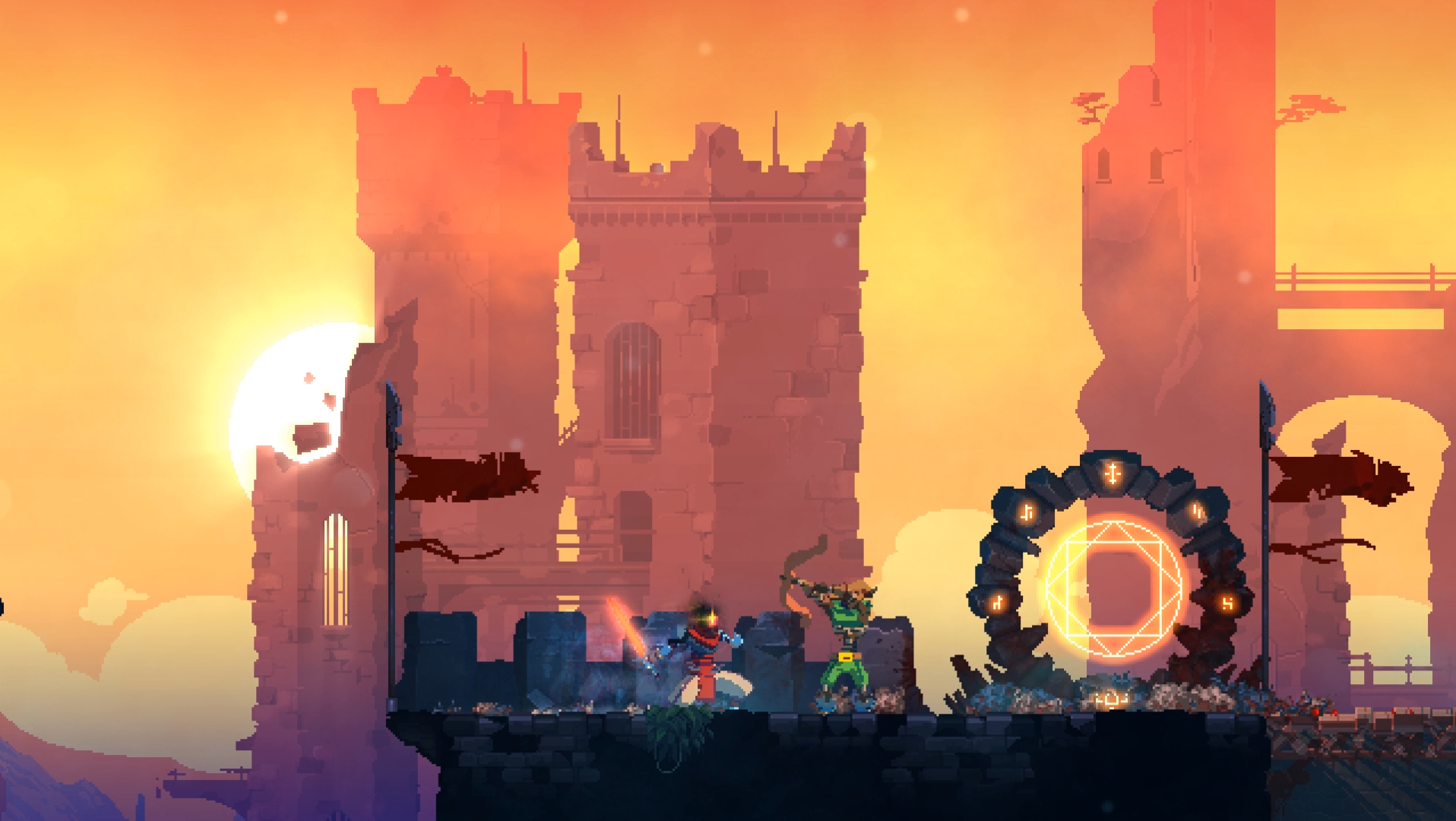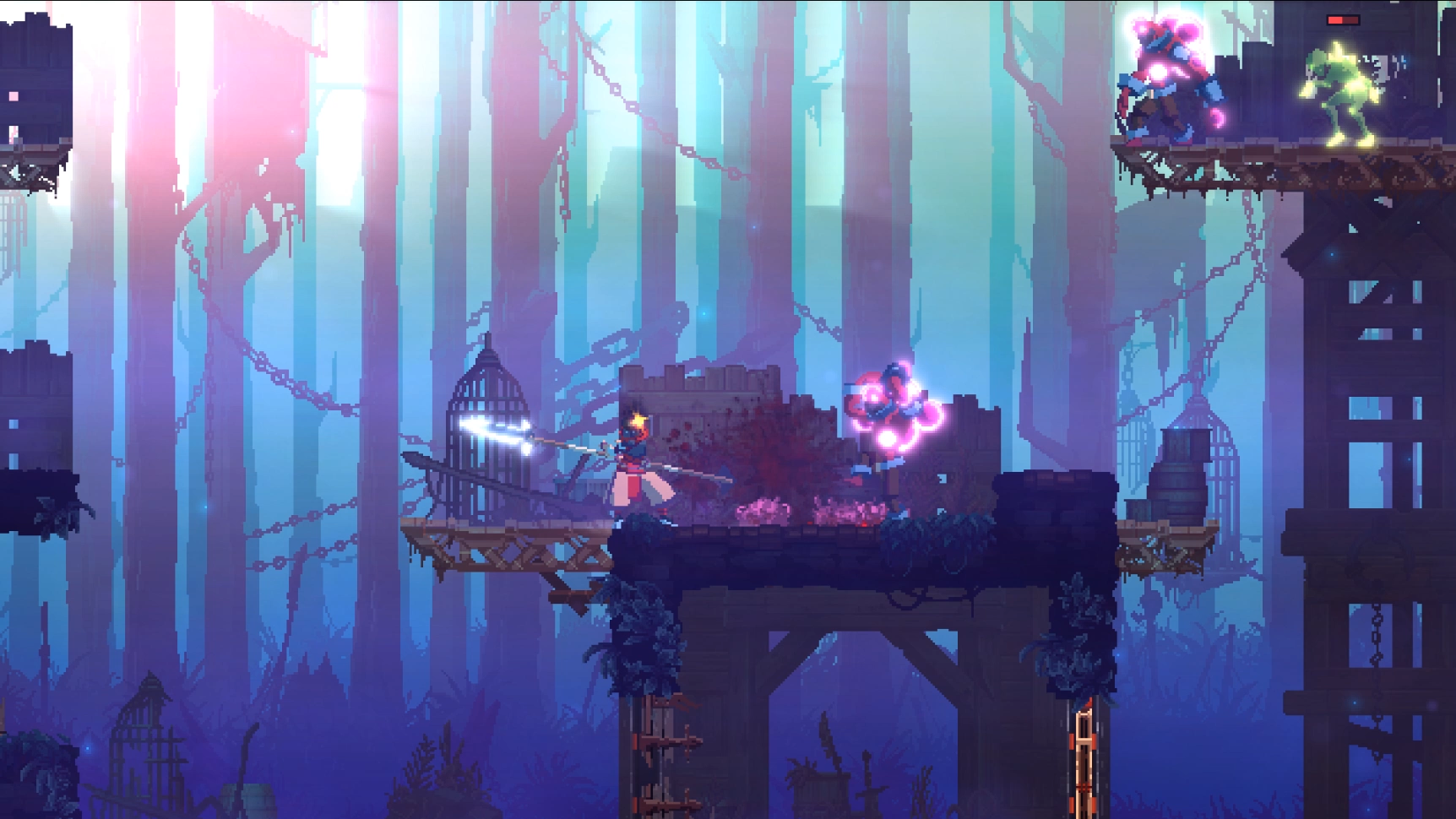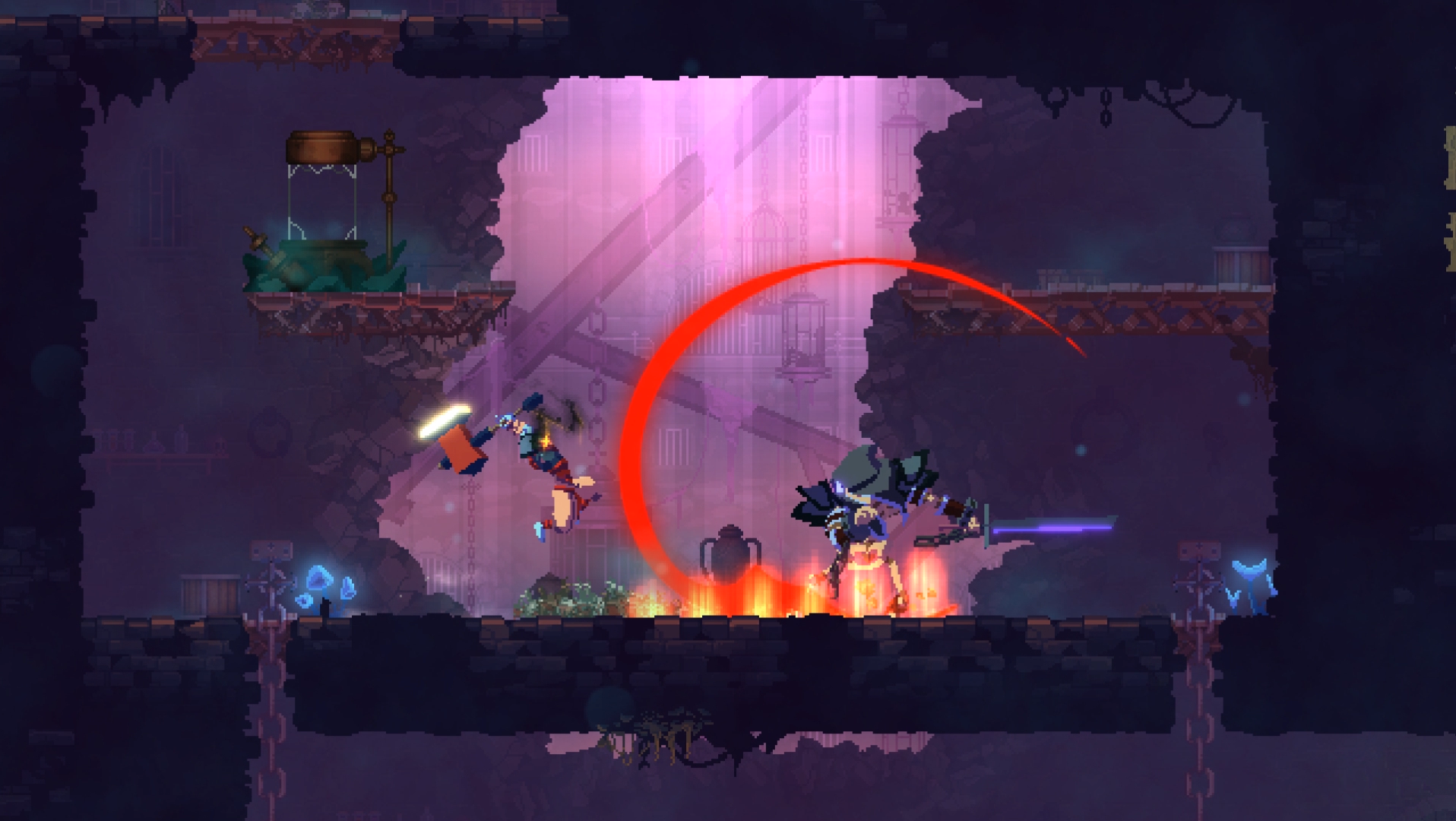Ever feel the need to embark on an adventure across a plague-ridden island, die a few times, and kill a king? Me neither. Apparently someone did, though, and brought us Dead Cells ($7.99), a kick-ass rogue-lite with more undead monstrosities than a bad horror flick. Not that you’ll notice them, though—you’ll be far too busy wondering where your head went, why you just can’t manage to stay dead, and what happened to throw this prison into such disarray. Don’t get so caught up in trying to solve these mysteries that you can’t take time to kick back and admire the view, though!
Dead Cells is fun. Actually, it’s really fun—one of the best games I’ve played this year, in fact. The art is beautiful, the gameplay is smooth, challenging, and rewards both practice and patience; the soundtrack is superb, and rewarding exploration with story is something I quite enjoy. It is, in a word, amazing. However, it is not perfect. Despite the effort to devise controls that feel natural and work well for a complicated and fast-paced game, they just aren’t good enough. Even with the extensive customisation available, it’s all too easy to whiff a dodge, botch a jump, or simply move the wrong way. Without a controller or a keyboard, the game becomes much, much harder, and it’s not a small difference.
Art and sound design are as integral to a game as the gameplay itself. Poor art or unsatisfying sound effects can turn an otherwise astounding game into a mediocre time sink at best. Similarly, incredible music and artwork can compensate for otherwise tedious or boring gameplay. Fortunately, there is no need to compensate for anything here. The music is fast, always pushing you to move just a little faster, go for just one more hit, and always take that risk. It’s a perfect fit for a fast game that pushes its players to always be on their toes. Similarly, the sound effects when hitting enemies, smashing to the ground, breaking down doors, or even getting hit, are impactful and satisfying, lending a certain weight to actions.
While the music and sound are good, the art is simply gorgeous. While it may be pixel art, it is incredibly detailed, well done, and did I say gorgeous? Take a break atop the Ramparts and admire the view, look out from the Clockmaker’s Tower at the clouded skies, or gaze at the island as a whole from the Throne Room. Wherever you are, and wherever you look, there is beautiful pixel art. Now, while being visually impressive is important, it does come second to conveying relevant information in a readable, and enjoyable, way. Dead Cells does this well too. Enemies are visually distinct, and have clean, clear animations. While there are a few exceptions, they are just that: Exceptions. Between the animations and enemy design, reading enemy tells and learning how to interpret them is made to be part of the fun, rather than a confusing obstacle.
Between the sound design and the art, Dead Cells feels really good to just sit and play. It’s not a game you can relax with, necessarily, not with its fast-paced nature, but it is a game that rewards a successful parry, or complementing one item with another for more damage, or a greater effect, or some other synergy. Finding and using these tricks accentuates the satisfaction of slamming down on an undead archer from above, pounding a scorpion with a hammer, evading a pouncing zombie, or putting a halt to a charge from a shieldbearer. It’s the little, individual feel-good things that add up to a sense of accomplishment when they are mastered and used to beat a particularly troublesome elite monster, or beat a boss, or race through a level in record time, that rewards all the practice and prematurely ended runs.
Sound design and art only play a partial role in determining how a game feels to play, though. The other, equally important, part is gameplay, and boy is the gameplay solid. At its most basic, Dead Cells is a 2D hack & slash platformer with combat reminiscent of Dark Souls, or Bloodborne—that is to say hard, unforgiving, and incredibly rewarding when it finally “clicks". Layered on that is a rogue-lite (or, as they call it, a “RogueVania") system, where death puts you back at the start, but with the benefit of preserving unlocked equipment and tools for use in the future. Finding all the different weapons and tools is reason enough to explore, but in addition to that there is usually more than one way to leave a stage. Whichever path you take the end is always the same, but the journey is different and offers different enemies and, as such, different equipment blueprints to acquire and secrets to find.
Building on the “RogueVania" idea, when gear and powers drop from enemies, it almost always drops as a blueprint which must be researched before it can be used. There are exceptions (notably amulets, monsters will occasionally drop usable equipment from what you have unlocked), but not many. If players die before they make it to a safe zone at the end of a biome, they lose any blueprints acquired, as well as cells and gold. In addition to unlocking new gear, these safe zones also provide the means to enhance equipment, heal up, and take a single mutation. These mutations are passive abilities that can provide a degree of flexibility, or double down on something you’re already good at. Choose wisely, though! You can only have three at a time, and it becomes very costly to reset them.
Everything about Dead Cells is fast and pushing you to go even faster. The music, the animations, the enemies walking around, bursting from the ground, or descending from the ceiling—everything. Move faster, hit faster, dodge later. It’s no wonder, then, that you’ll eventually slip up and take a hit here and there. For quite a while that’s alright—there’s a lot of healing in the biomes themselves, nevermind the free healing after each. All you’ve really lost is your untouchable status which is, admittedly, valuable. But then you beat the game and unlock your first Boss Stem Cell. All of a sudden, the kid gloves have come off. There’s less healing, and harder enemies appear earlier. Every hit feels like it hurts twice as much, enemies feel twice as tough, and there are twice as many. Oh, and those free health refills between each stage? Those are gone too. Good luck!
With the precision required to time dodges and still get hits in, it’s no wonder why controls are so important. Before I rip on them, though, it’s worth noting that Playdigious has done an admirable job with onscreen controls. They are good, and they may even be good enough with practice. By default, they are arrayed in a way that makes sense: The jump, dodge, and interact buttons are easy to reach and close to the side of the screen, and the buttons to activate your gear are a little to the left. They aren’t quite as easy to reach, which is unfortunate, they are not uncomfortably far away. Movement is handled on the left side of the screen with either a floating touch pad or a fixed touch pad (changeable in the settings). Not so bad, right? Maybe a little complicated, but that’s alright! And it is. Until a parry is the difference between dying and not, or five seconds are the difference between finishing the stage in time and not, or the only way to avoid taking damage is to immediately drop down and execute a downward slam. These are not niche situations either; they occur regularly, and without precise controls and a familiarity with them, it’s very hard to successfully navigate any of them. So while the onscreen controls may be good, they are simply not as good as a controller. Fortunately, for those who have an MFi controller handy, or those who are running the iOS 13 beta, you can use a controller.
Is Dead Cells well suited to being a mobile game? Personally, I think so, but I would also love to see games like Stellaris or Mirror’s Edge on mobile as well. Generally speaking, if the thought of using a controller to play a game on your iPhone or iPad is anathema, then this is almost certainly not the game for you. On the other hand, if that sounds like the greatest thing since sliced bread and goat cheese, you’re in the right place at just the right time. But, regardless of platform or what controls you choose to use, there’s no question about it: Dead Cells is an amazing game, and anyone interested in rogue-lites would be well advised to give it a shot at their earlies convenience.
 Like this article?
Like this article?
We pride ourselves on delivering quality, long-form articles like this one instead of the SEO-driven click bait that is slowly taking over the internet. Unfortunately, articles like these rarely generate the traffic (and as a result, the ad revenue) of listicles, cheat guides, and other junk.
Please help us continue producing content like this by supporting TouchArcade on Patreon, doing your Amazon shopping by first visiting toucharcade.com/amazon, and/or making one-time contributions via PayPal.
from TouchArcade https://ift.tt/2NBH7UA



0 comments:
Post a Comment